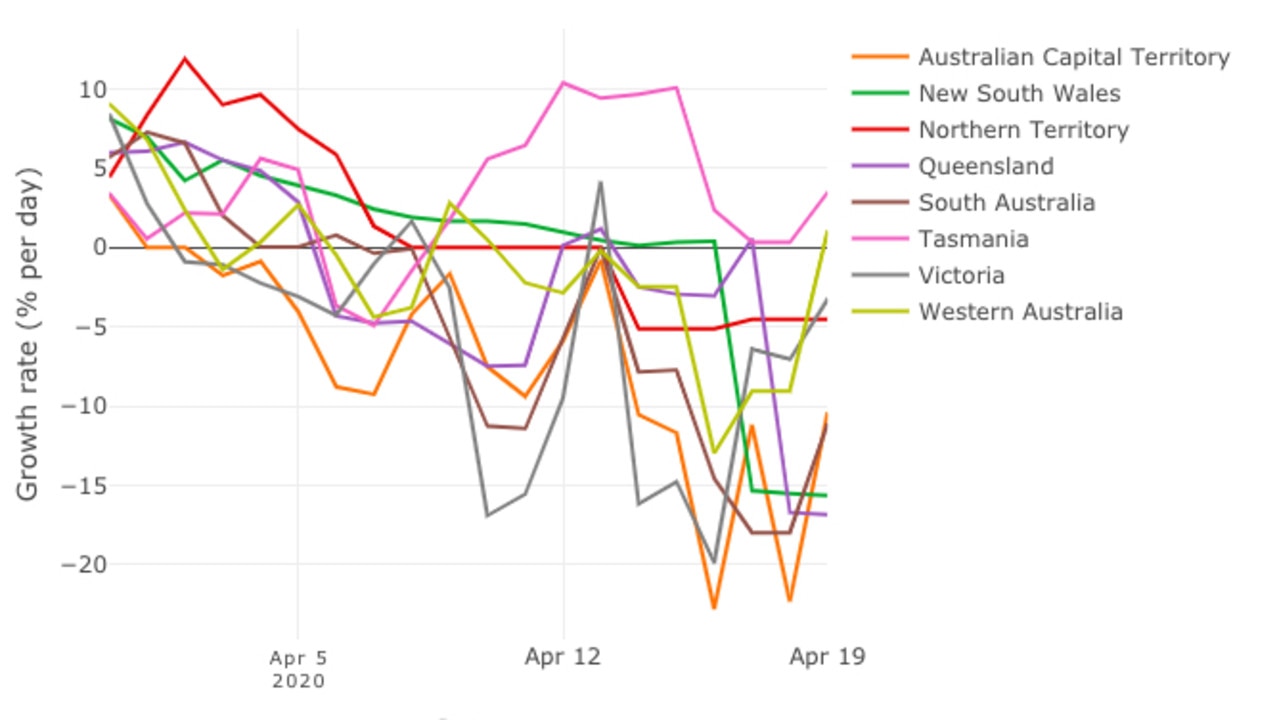Coronavirus Australia: Restrictions had dramatic effect on virus growth
A professor says virus restrictions have had a “dramatic effect” on how Australia’s COVID-19 cases will grow over the next 10 days.

Tough restrictions implemented by federal and state governments in Australia to stem the coronavirus outbreak have had a “dramatic effect” on how COVID-19 infection numbers will grow over the next 10 days, one expert has said.
University of Melbourne associate professor Ben Phillips says thanks to steps taken by authorities to “flatten the curve”, the nation is in “the enviable position of having negative growth rates”.
A combination of widespread social restrictions, increased testing and closing national and (most) state and territory borders have helped to successfully kerb the spread of the potentially-deadly virus. In NSW, the state hardest hit by the outbreak, just six new infections were recorded this morning.
“Case numbers are expected to continue dropping across the nation,” Prof Phillips told news.com.au.
“If things continue as they have been we will move to around 700 cases or less, from our current caseload of 2356.
“All of the difficult decisions that have been made, from those of individuals through to businesses and state and federal government, have had a dramatic effect. There is no doubt that we have, at this stage, averted a crisis, and we can be proud of that.”
RELATED: Follow the latest coronavirus updates
RELATED: First and last virus measures to be lifted


Prof Phillips, a population ecologist who specialises in invasive populations, developed an interactive site which uses raw data to estimate how many cases there will be in 10 days if the nation continues on the same trajectory of infections.
Using figures from the frequently-updated John Hopkins University dataset, the forecast, he explained, was designed to “move us past the daily shock of increasing case numbers, and towards a view of the new future”.
“Once action has been taken, the forecast gives us a sense of how our actions have affected growth. It shows us when we are winning, and it allows us to compare countries and states to see how each is faring.”
Multiple state leaders and authorities have commended Australians on their efforts to help stop the COVID-19 spread, with national Chief Medical Officer Brendan Murphy saying it’s “quite possible” the virus could be eradicated in parts of the country.
“Some states have had no cases for some days and small numbers of cases all imported. We are on the same trajectory as New Zealand, which is heading for elimination, and if we achieve complete lack of transmission and no cases, that would be great.”
And while there’s talk of some restrictions being eased over the coming weeks and the government is under a “lot of real pressure” to allow Aussies to return to normal life, Prof Phillips has warned that we cannot “rest on our laurels. There is no doubt that we need to continue our efforts”.
“The worst case scenario would be that we ease restrictions and there are undetected cases that set off an outbreak. Hence we need to maintain our vigilance,” he said.
RELATED: How Australia smashed the virus curve
RELATED: Virus graph predicts rising death toll
The risk of an undetected outbreak or second wave is “very real” if the pressure is lifted, he said, and “such an outcome would very quickly set us back and could have us in real trouble. So there is a delicate balance to be made, and it needs to be made carefully”.
Australia and New Zealand – where even tougher “Level 4” measures were put in place by Prime Minister Jacinda Ardern in an effort to stamp out the virus completely – are in a position to eliminate the virus within our borders, Prof Phillips explained – an opportunity that has passed for many other countries until a vaccine arrives.
This was something we achieved by acting early, acting “with unity”, closing the borders, and investing heavily in testing and surveillance, Prof Phillips said.
“If we can eliminate cases in Australia, we could largely get back to normal activities, but we would have to maintain very strong border quarantine until a vaccine arrives.”
The alternative, he suggested, would be eight months to a year of cycling in and out of lockdown as we attempt to flatten the epidemic curve, which would have a much larger toll on both health and economy.




